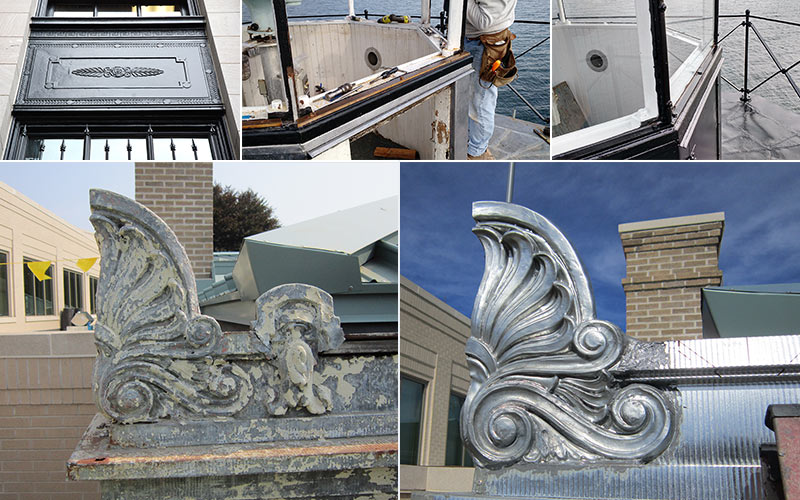Why Kronenberger & Sons Leads in Metal Restoration
When a building’s metal elements begin to show wear, corrosion, or damage, high‑quality metal restoration is essential. Kronenberger & Sons Restoration, Inc. (KSR) specializes in this niche, offering skilled repair and preservation services for sheet metal, gutters, downspouts, copper roofing, and ornamental metal components. Their expertise blends historic‐sensitivity with technical precision, ensuring long‐term durability and visual integrity.
What Metal Restoration Entails at KSR
Restoration at KSR involves a range of specialized services tailored to preserve and restore historic or aging metal building elements. These include:
- Cleaning, polishing, and buffing metal surfaces to restore original luster.
- Removal of coatings, paint or corrosion and applying new protective finishes.
- Soldering, welding, and epoxy repairs where structural integrity has been compromised.
- Repair or replacement of flashing, gutters, downspouts, copper roofing and weathervanes to match historic profiles and specifications.

Through these steps, KSR ensures that metal elements are not just visually restored, but also practically restored—meaning they perform effectively, shed water, resist deterioration, and maintain historic character.
Why Choose KSR for Metal Restoration
Selecting Kronenberger & Sons for your restoration needs means you benefit from:
- Specialized Craftsmanship: The firm’s craftspeople are experienced in working with sheet metal, ornamental metal details, and heritage structures—ensuring appropriate materials and techniques.
- Historic Preservation Awareness: Rather than rebuilding from scratch, their approach focuses on restoring original materials where possible and preserving architectural authenticity.
- Comprehensive Service Range: Because KSR handles many facets of restoration (wood, masonry, metal, windows, doors), metal restoration integrates well into a broader renovation or preservation project without disjointed subcontracting.
- Attention to Detail & Safety: For historic buildings especially, dealing with lead paint, old coatings, and hidden deterioration in metal components is critical. Their approach prioritizes safe, accurate restoration.
The Process: From Assessment to Completion
A typical restoration project with KSR follows a structured process:
- Assessment & Documentation: Identifying the extent of metal damage, corrosion, structural issues and creating a restoration plan aligned with historic standards.
- Craftsman Work: Skilled trades handle cleaning, repair, welding, soldering or replacement of metal components as needed—matching original profiles and materials.
- Protection & Finish: Applying appropriate coatings or finishes (paint, sealant, patina restoration) to extend the lifespan of restored metal work.
- Integration with Building Envelope: Ensuring that restored metal elements (gutters, downspouts, flashing) link properly to roofing, masonry, and structural systems for effective performance.
- Final Review & Maintenance Strategy: Confirming durability, aesthetic outcome, and providing a plan for ongoing maintenance so the metal restoration endures.
This process ensures the outcome is both visually accurate and functionally sound.
Applications: Where Metal Restoration Matters
Restoration is critical in several contexts:
- Historic landmarks: Churches, town halls, libraries and other period structures often have copper roofs, elaborate flashing or decorative metalwork that must be preserved. KSR works on many such buildings.
- Architectural detail enhancements: Whether a building’s railings, weathervanes or metal trim have deteriorated, restoration keeps character intact and prevents further decay.
- Weather‑exposed elements: Roof flashing, gutters and downspouts endure harsh conditions. Without proper metal restoration, leaks and structural damage can follow.
What to Consider When Planning Metal Restoration
If you’re evaluating a restoration project, keep in mind:
- Material authenticity: Does the restorer use correct gauge sheet metal, matching historic profiles and materials?
- Finish and protection: Are coatings appropriate for the exposure and environment? Will they maintain performance?
- Integration: Metal elements must integrate with roofing, masonry and structural systems—isolated metal work rarely performs long term.
- Maintenance plan: Following restoration, ongoing care extends life. Scheduling inspections, cleaning and re‑coating can prevent future costly repairs.
- Specialist skills: Restoration requires more than general contracting—look for craftsmen experienced in welding, soldering and historic detailing.
Kronenberger & Sons scores high on all these criteria, making them a reliable choice for serious metal restoration projects.
Conclusion
When building or preserving architecture with exposed or decorative metal elements, prioritizing professional metal restoration is essential. Kronenberger & Sons Restoration, Inc. combines decades of heritage expertise with skilled craftsmanship and a preservation‑first mindset. Whether the job involves copper roofing, flashing, gutters or architectural metal ornamentation, choosing a specialist restores both the function and the historic value of metalwork. With attention to authenticity, durability and detail, KSR remains a leading name in restoration for historic and high‑value structures alike.